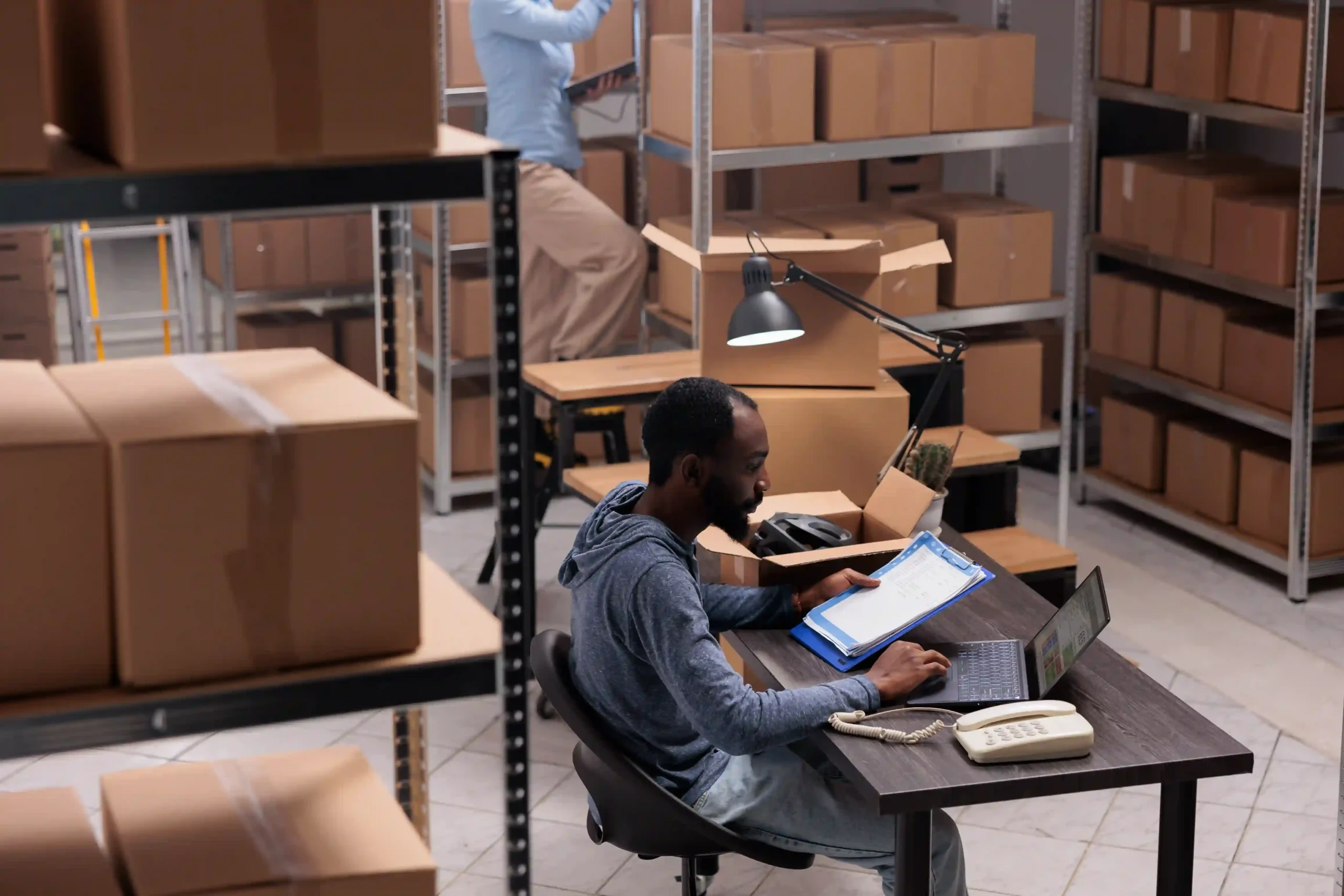The importance of warehousing lies in its role as the engine room of supply chain logistics. It’s the process of safely storing goods, managing inventory, and preparing products for shipment to customers.
But from where I sit, with 35 years running a 3PL and Foreign Trade Zone company like Tri-Link FTZ, it’s much more than that. Warehousing supports smooth operations, boosts profitability, and ultimately strengthens the backbone of your business.

I remember when warehousing meant stacks of boxes and little more than a clipboard to keep track of inventory. Fast-forward to today, and things look very different.
Modern warehousing is one of the most strategic components in the logistics toolkit. It’s what lets us respond faster to customer needs, cut unnecessary costs, and scale with confidence.
Especially in industries like eCommerce, manufacturing, or food service, having the right warehousing setup can mean the difference between thriving and barely surviving. From a high-level view, warehousing connects the dots between production, transportation, and customer delivery.
It’s where raw goods become organized assets, where your product’s journey is paused before the final mile. When you understand the importance of warehousing, you see it’s not about storing boxes—it’s about creating flexibility, responsiveness, and control across the supply chain.
And if you’re in a competitive market, those three things aren’t just nice to have—they’re essential.
In every logistics setup I’ve overseen, warehousing is the glue that holds it all together. The supply chain is like a relay race—every handoff must be smooth and efficient.
Warehousing is the exchange zone. Manufacturers send in products, and through warehousing, we process it, hold it, and eventually hand it off to distribution or the customer.
If warehousing fails, the whole chain suffers. What’s interesting is how often companies overlook this part.
They think supply chain success is all about fast delivery or flashy tech. Those things help, but without a strong warehouse function, the rest collapses.
A warehouse gives businesses the time and space to breathe. It allows inventory to wait until the right moment to ship.
It gives us a way to manage demand spikes, handle returns, or group products for efficient shipping. It even serves as a central hub for repackaging, product testing, or last-mile customization.
If you’re looking at the supply chain as a whole and trying to optimize it, don’t start with trucks or delivery times. Start with your warehouse.
It’s where the magic (or the mess) usually begins
Over the years, I’ve worked with businesses ranging from garage startups to Fortune 500 manufacturers, and I can say with confidence that the importance of warehousing doesn’t depend on company size—it’s universal. Small businesses use warehousing to gain flexibility without massive infrastructure costs.
Medium-sized businesses rely on it to stabilize cash flow, manage growth, and avoid customer disappointment. And large enterprises?
For them, warehousing is essential for global coordination and efficiency. A warehouse allows you to place larger, more cost-effective orders with suppliers.
Instead of running on razor-thin just-in-time schedules, you can stock strategically, taking advantage of supplier discounts and avoiding delays. You also gain control over your supply-demand rhythm.
In peak seasons like the holidays or Black Friday, being able to stock in advance is a game-changer. One of our clients, an eco-packaging company, scaled from 2,000 to 25,000 monthly shipments in just 18 months.
What unlocked that growth? A flexible warehousing model that lets them test markets, shift inventory between zones, and reduce lead times by nearly 40%.
Warehousing wasn’t just a backend tool—it was their launchpad.

A common misconception is that warehousing is just about storing goods. But there are five major functions we implement in every facility we manage:
First, there’s receiving—getting the product off the truck, verifying it against orders, and checking for damages. This is where problems get caught early before they snowball.
Then we move to inventory storage, which isn’t about stacking things randomly but designing optimal layouts based on SKU velocity, temperature needs, and handling frequency. Next comes order picking and packing.
Accuracy and speed are critical here. A well-run warehouse gets orders out faster, with fewer mistakes, and that directly impacts customer satisfaction.
Fourth is shipping and dispatch, where we coordinate carriers, label loads, and track movements to the final destination. Finally, there’s returns and reverse logistics—a growing part of warehousing as eCommerce expands.
Warehouses must now process returns quickly and responsibly, often refurbishing items or handling waste sustainably. Together, these five pillars form a system that drives operational success from the inside out.
Inventory management is both an art and a science. Without the structure of a warehouse, businesses risk miscounts, shrinkage, and stockouts.
With one, they gain visibility, accuracy, and responsiveness. At Tri-Link FTZ, we deploy systems that track inventory levels in real time using barcodes, RFID tags, and warehouse management software (WMS).
These tools don’t just tell us what’s on the shelf—they inform purchasing decisions, restock alerts, and even product forecasting. Think of the chaos without it: duplicate orders, missing items, overstocked slow-movers eating up space.
A good warehouse fixes that. It allows for cycle counting, slotting optimization, and demand planning. It transforms your stock from a cost center into a profit driver. When inventory is managed well, fulfillment naturally improves.
We’re able to pick faster, bundle smarter, and reduce order errors. Happy customers aren’t just those who receive their products on time—they’re the ones who receive exactly what they ordered, in perfect condition, every time. Read more here.
Let’s talk numbers. Warehousing, done right, cuts costs across the board. I’ve seen it slash transportation spend by consolidating loads and placing products closer to final destinations.
It also trims labor costs by reducing time spent searching for inventory or fixing fulfillment errors. One of our clients cut their per-order cost by 18% just by redesigning their pick-and-pack process.
With warehousing, we can batch shipments, combine inbound and outbound freight, and even minimize packaging waste. We can share space across clients (multi-client warehousing) or use cross-docking to get items in and out within hours instead of days.
Here’s a simple breakdown of where savings come from:
Cost Area | How Warehousing Reduces It |
Freight Costs | Shortens final-mile delivery distance |
Labor Costs | Streamlines picking, packing, and staging |
Inventory Holding | Prevents overstock and obsolete goods |
Damage & Returns | Improves handling with better systems |
Fulfillment Errors | Cuts costly reships and unhappy customers |
Over time, the importance of warehousing becomes very clear in your bottom line.

There’s no one-size-fits-all in warehousing. I’ve built out cold storage for pharmaceutical clients, fulfillment centers for fashion startups, and bonded warehouses for international auto parts suppliers.
Understanding which model fits your business is half the battle. Fulfillment centers are designed for speed.
They’re perfect for DTC brands and eCommerce sellers. Cold storage facilities maintain strict temperature controls—vital for food, medicine, and even certain electronics.
Public warehouses offer flexible, shared-use space ideal for small to mid-size businesses. Private warehouses, while more costly, give total control to the operator.
Foreign Trade Zones (FTZs)—like those managed by Tri-Link—add unique value. They help businesses defer duties, streamline customs clearance, and hold imported goods until they’re needed.
For import-heavy businesses, the savings can be substantial. Each model serves a different purpose, but they all reinforce one truth: warehousing, when matched correctly to your operations, unlocks exponential gains. Read more here.
Warehousing isn’t just manual labor anymore. Today, it’s powered by data, sensors, and automation.
I’ve watched warehouses evolve into nerve centers that track, analyze, and optimize every movement in real-time. We use warehouse management systems (WMS) that integrate with ERP, TMS, and CRM platforms.
RFID scanners automate stock tracking. IoT sensors monitor temperature, humidity, and even movement across the facility.
Robotics handle repetitive tasks like shelving and order picking. It’s efficient, accurate, and scalable. Smart warehousing also helps reduce waste, energy use, and human error.
And it provides better reporting—so you can make smarter decisions faster. For any business looking to grow sustainably, technology isn’t optional.
It’s the edge.
In our industry, delays and mistakes cost more than money—they cost trust. When your warehousing is solid, your customers feel it.
Orders arrive faster. Returns are easier.
Stock is available when they need it. Warehousing lets us manage seasonal spikes without delays.
It allows for custom packaging, kitting, or promotional inserts. And when we position inventory close to key markets, we shorten delivery windows from days to hours.
Customers don’t want to hear about your supply chain—they just want their order. A great warehouse makes that happen consistently, and that consistency builds loyalty.

Just as good warehousing lifts a business, poor warehousing drags it down. I’ve seen businesses suffer due to lost inventory, fulfillment delays, or data gaps.
These risks are real—and they grow with your business if they’re not addressed early. Without a strong warehousing strategy, you risk over-ordering, under-stocking, and driving up returns.
Operational costs climb, customer satisfaction drops, and opportunities are missed. And then there’s safety. Warehouses that aren’t optimized can become hazardous.
Sloppy layouts, poor equipment, and untrained staff create an environment ripe for injury or theft. That’s why we invest in proper layout design, safety protocols, and constant training.
The right warehouse for your business depends on your product, your customer, and your growth plan. When clients come to us, we ask questions: How fast do you need to ship?
Where are your customers? What systems are you using now?
Sometimes the answer is a shared 3PL facility. Other times it’s a dedicated space.
For companies with global sourcing, FTZs make a lot of sense. We help match businesses to the best model—and we always build with scalability in mind.
Choosing wrong costs more than just money—it slows you down. So whether you’re growing a new brand or optimizing an enterprise network, take warehousing seriously.
Share this article
We have other resources available upon request as well as one-on-one support and personalized answers, just like our services.
Simply contact us anytime and we’ll get back to you to answer your questions and provide meaningful answers that show you how Tri-Link supports your logistics, reduces costs, and accelerates efficiency.
Tri-Link delivers exceptional FTZ and 3PL services tailored to your global trade needs.
Our solutions combine innovation, quality, and efficiency to exceed your expectations and meet your specific requirements.